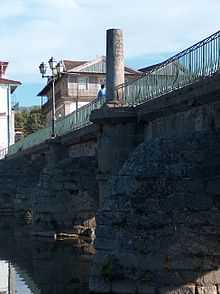Aquae Flaviae



Aquae Flaviae is the ancient Roman name for the current city of Chaves, Portugal.
Pre-Roman occupation
The city was a center of pre-Roman occupation, being the main town of the Turodi people.[1]
Roman domain
Aquæ Flaviæ was a major city in the Roman province of Gallaecia, an important and strategic post, where three of the most important Roman roads converged: the roads to Bracara Augusta, Asturica and Lamecum. There was much movement between Bracara Augusta and Asturica, for the region had natural resources that were exported to Rome.
The city achieved municipium status in 79 AD by Vespasian.[1]
Urban structure
Trajan bridge
Trajan's bridge over the river is a Roman monument that persists. It was built between the 1st and 2nd centuries AD.
The bridge has a board with 140 metres in length, supported by twelve visible arches, with other six not visible (buried by houses).[1] It is the main symbol of the modern city of Chaves. When the town received the charter of Manuel I, the bridge was represented in the coat of arms.
The bridge has two middle columns with inscriptions regarding its construction.
One is from the time of Vespasian (known as Padrão dos Povos - Column of the Peoples) and mentions the civitates dependant of Aquae Flaviae: Aquiflavienses, Avobrigenses, Bibali, Coelerni, Equaesi, Interamici, Limici, Naebisoci, Querquerni and Tamagani. The Roman legion Legio VII Gemina Felix is also mentioned.
Transcription:[2] IMP(eratori) CAES(ari) VESP(asiano) AVG(usto) PONT(ifici)/ MAX(imo) TRIB(unicia) POT(estate) X IMP(eratori) XX P(atri) P(atriae) CO(n)S(uli) IX/ IMP(eratori) VESP(asiano) CAES(ari) AVG(usti) F(ilio) PONT(ifici) TRIB(unicia)/ POT(estate) VIII IMP(eratori) XIIII CO(n)S(uli) VI[I]/ (...)/ C(aio) CALPETANO RANTIO QUIRINALI/ VAL(erio) FESTO LEG(ato) AVG(usti) PR(o) PR(aetore)/ D(ecimo) CORNELIO MAECIANO LEG(ato) AVG (usti)/ L(ucio) ARRVNTIO MAX(imo) PROC(uratori) AVG(usti)/ LEG(io) VII GEM(ina) FEL(ix)/ CIVITATES X/ AQVIFLAVIENSES AVOBRIGENS (es)/ BIBALI COELERNI EQVAESI/ INTERAMICI LIMICI NAEBISOCI/ QUERQVERNI TAMAGANI
Another (Column of Trajan) dates from the Trajan reign (104 DC).
Transcription:[2] IMP(eratori) CAES(ari) NERVA/ TRAIANO AVG(usto) GERM(anico)/ DACICO PONT(ifici) MAX(imo)/ TRIB(unicia) POT(estate) CO(n)S(ule) V P(atri) P(ATRIAE)/ AQVIFLAVIENSES/ PONTE LAPIDEVM/ DE SUO F(aciendum) C(uraverunt)
Roman bath
Also famous was the Roman bath, which is believed to have lasted until the 16th century. The original structures, including two large pools, still intact and fed by hot springs, were discovered in 2006 and excavated until 2009. This spa complex has been dated from the 3rd century AD.
Other Roman structures
Other Roman remains include an aqueduct and Roman dam (at Abobeleira). An amphitheater is know to exist from inscriptions mentioning gladiators, but its exact location in not known.
Coordinates: 41°44′20″N 7°28′08″W / 41.739°N 7.469°W
References
- ↑ 1.0 1.1 1.2 Portugal Romano. "Aquae Flaviae (Chaves)". Portugalromano.com. Retrieved 2011-11-09.
- ↑ 2.0 2.1 "Fornecido pelo Google Docs". Docs.google.com. Retrieved 2011-11-09.